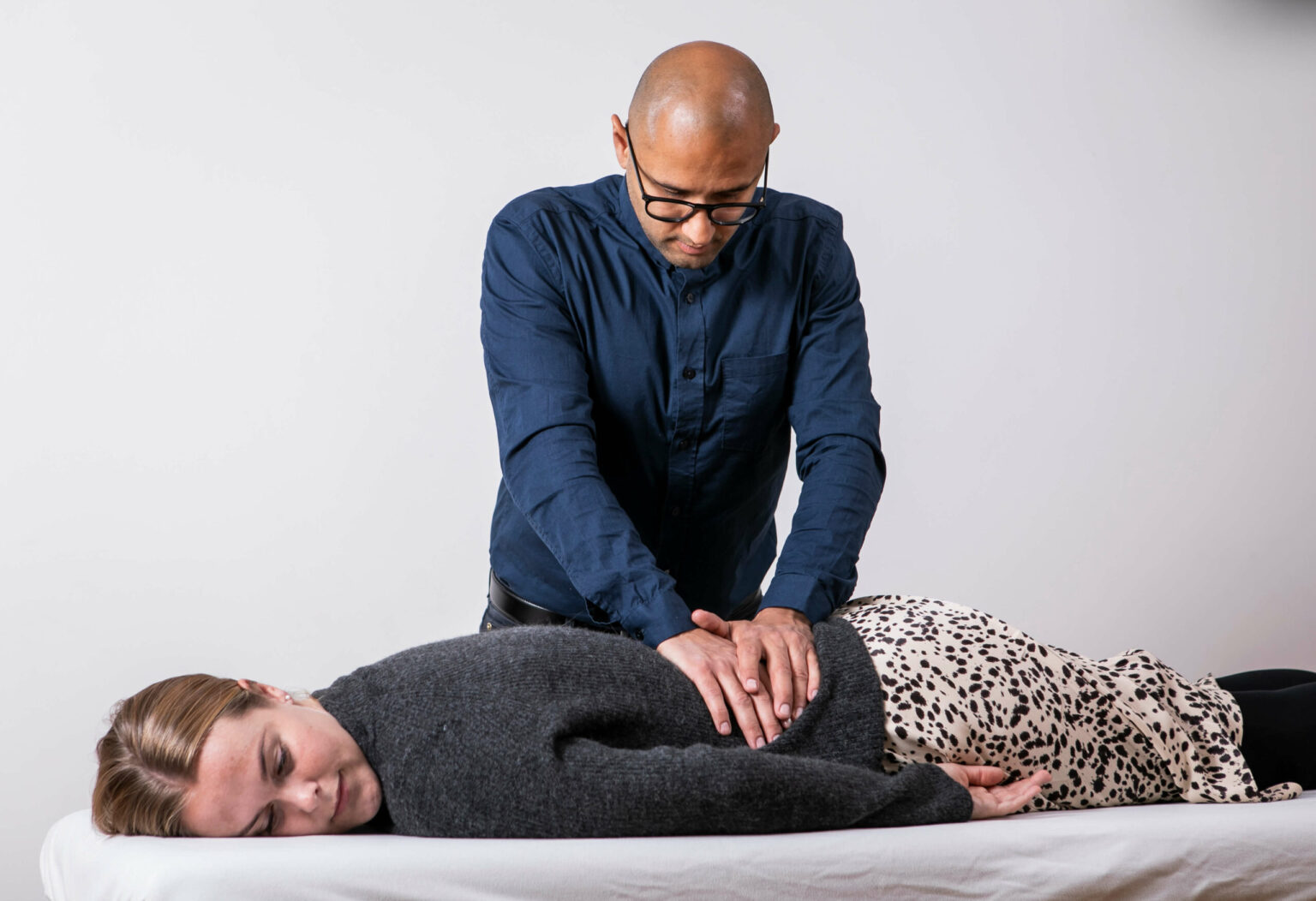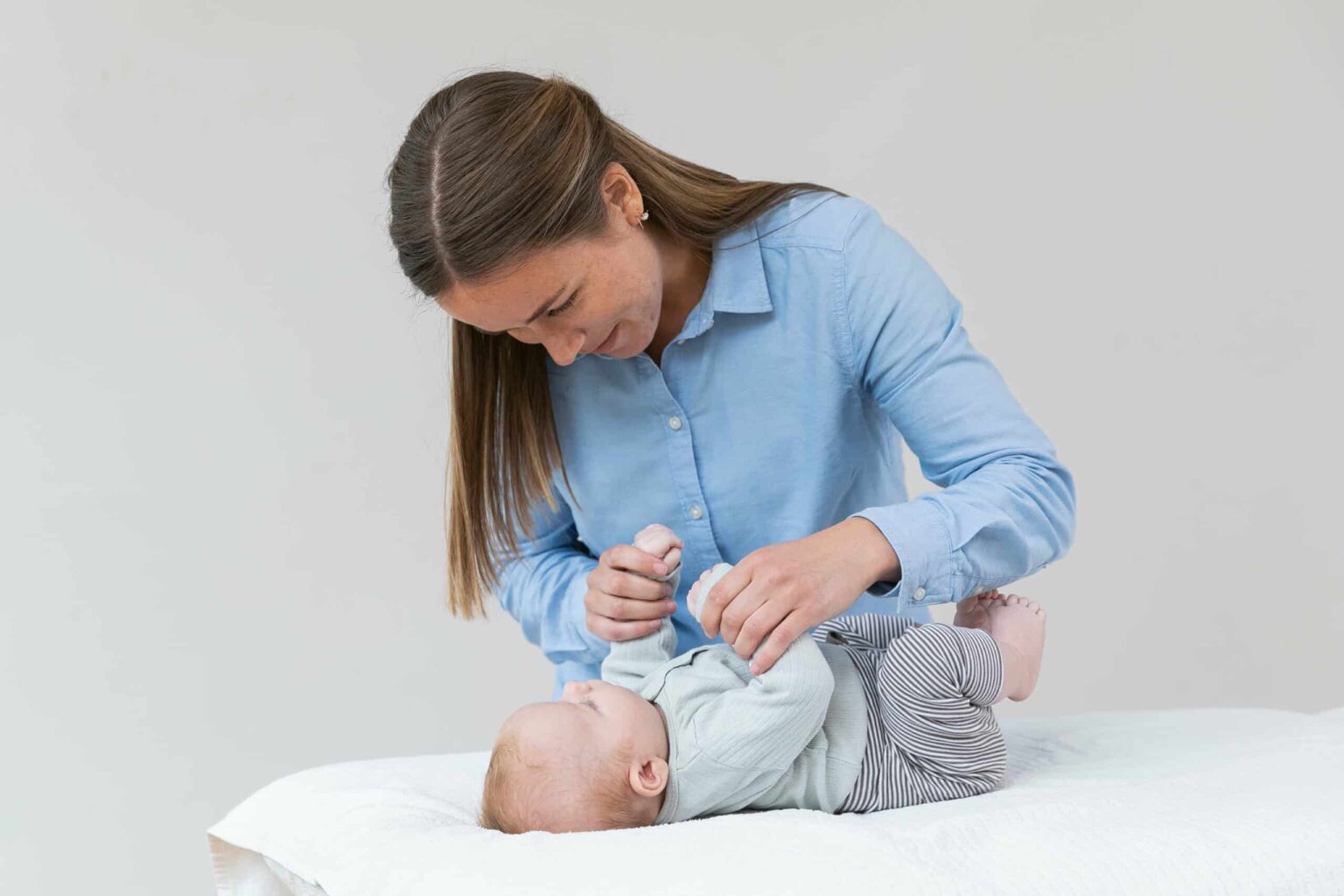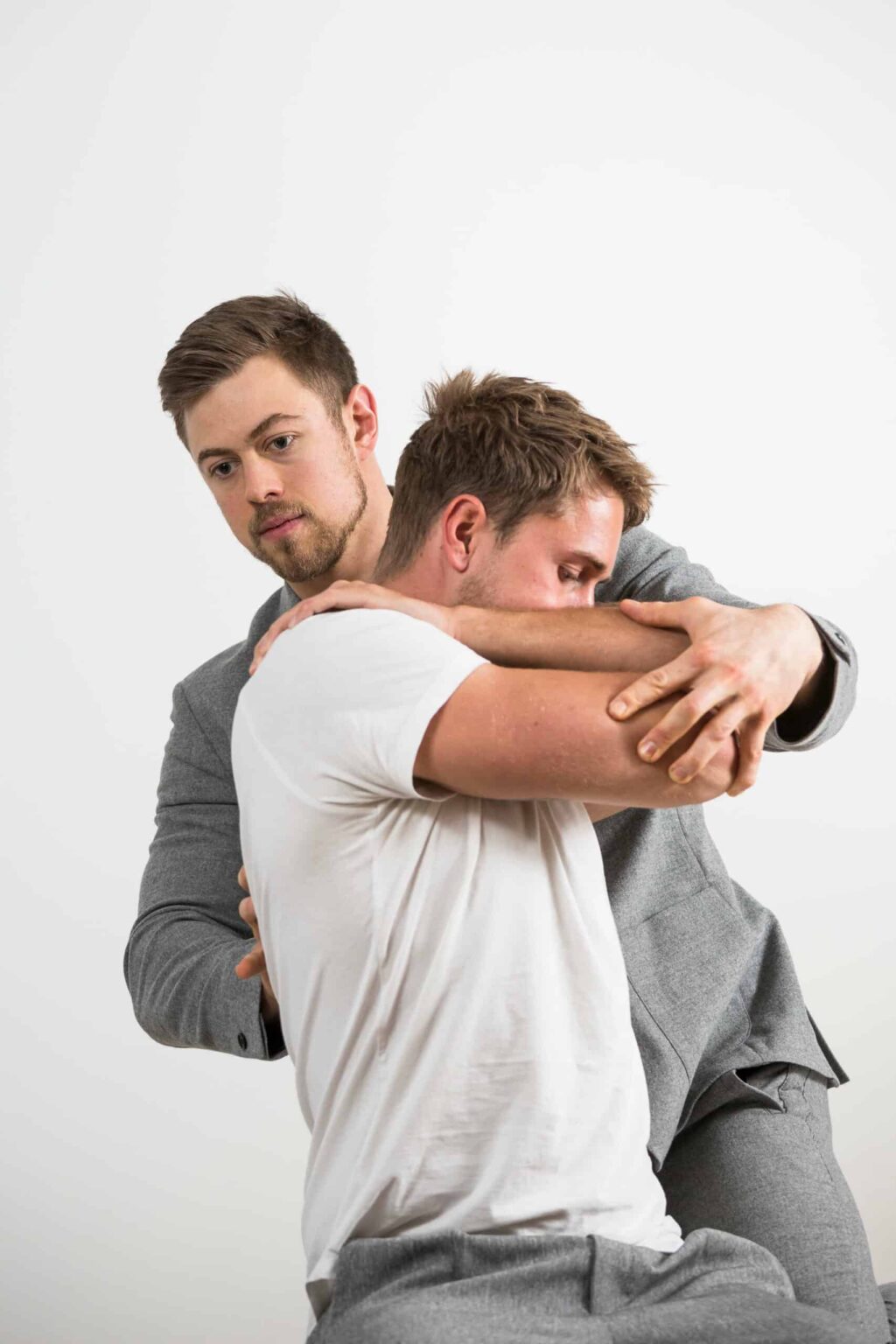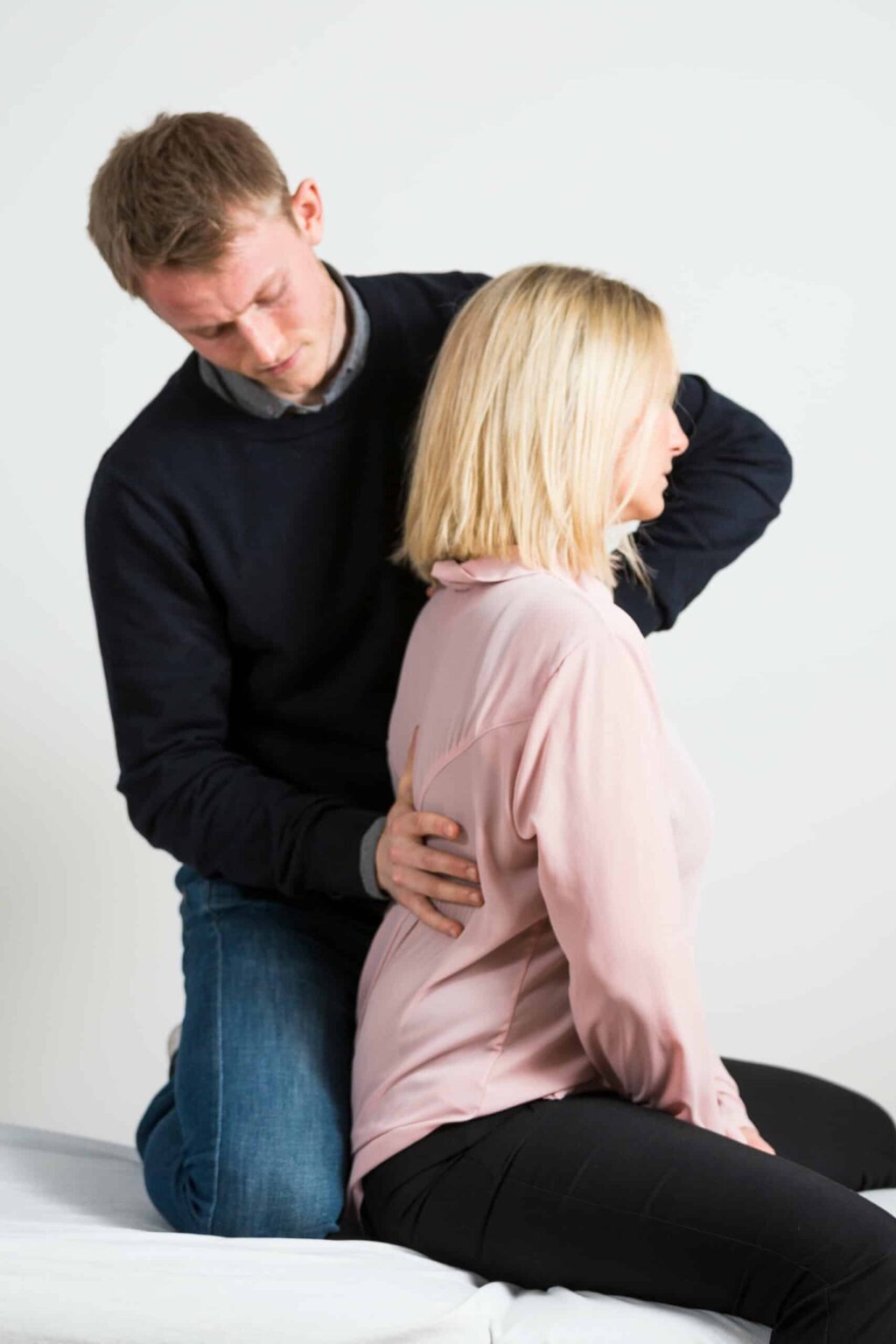We treat
Spinal arthritis
Learn more about spinal arthritis - also known as spondyloarthritis
What is spinal arthritis?
Spinal arthritis is a collective term for several conditions that can occur in the spine, all of which are characterized by being inflammatory.
The collective term spinal arthritis covers the following:
– Bechterew’s disease
– Psoriatic arthritis
– Reactive arthritis (Reiter’s disease, post-infectious arthritis)
– Enteropathic arthritis (gout) in inflammatory bowel disease (Crohn’s disease and ulcerative colitis)
– Undifferentiated spondyloarthropathy
Jump to section [Vis]
Spinal arthritis
In spinal arthritis, an inflammatory condition occurs in the adhesions between the discs and the corresponding vertebra. The inflammation creates swelling and pain, while both the discs and the adhesions between them lose their elasticity. The increased stiffness in the tissue after the inflammation contributes to movement restrictions in the spine.
In the long term, the inflammatory process will cause some of the tissue at the discs and the attachments to decay. As a consequence of this, the body will form new bone tissue, also called osteophytes/syndesmophytes. In particular, in spondylitis, bone formation is called syndesmophytes, which gives the spine an appearance like a bamboo pole on an X-ray.
Sources: Sundhed.dk & Gigtforeningen.dk

Spinal anatomy and the impact of arthritis
The spine is made up of 33 vertebrae with varying appearances, distributed as follows:
- 7 cervical vertebrae
- 12 vertebrae in the thoracic spine
- 5 lumbar vertebrae
- 5 fused pelvic vertebrae (sacrum)
- 4 fused vertebrae (coccyx)
The vertebrae of the spine are separated by a disc, except between the fused vertebrae that form the sacrum and coccyx. The purpose of the discs is to ensure that the spine is mobile, and in pictures you can see that the discs vary in thickness depending on where in the spine they are located.
Discs are made up of a relatively soft core called the nucleus pulposus, which is surrounded by a strong outer ring called the annulus fibrosus. The upper and lower parts of the disc are fused with the corresponding vertebra above and below.
The adult back consists of 4 curves that contribute to a shock-absorbing function. The curves are called lordosis and kyphosis. The neck and lower back naturally have a lordosis, while the thoracic spine and pelvis have a kyphosis.
Inflammation of the spine
In inflammatory diseases of the spine, it is typically the connection between the disc and the vertebra that is affected. In long-term inflammation of the spine, calcifications will occur later in the process in the outer part of the disc, the annulus fibrosus, which is normally a strong cartilage tissue with a slight elastic ability. This elasticity is reduced by calcifications. At the same time, osteophyte formations can occur at the ends of the vertebrae, which will cause the vertebrae to become wider at the bottom and top, which will limit the mobility of the spine.
The lower back and thoracic spine will eventually become more kyphotic, so you will eventually become more bent forward.
Causes and underlying mechanisms behind spinal arthritis
The reason why people develop spinal arthritis is not known. However, a connection has been found between familial diseases that are predisposing, but also other diseases in the body that can increase the risk of developing spinal arthritis.
It is expected that it is probably due to a complex interaction between genetic predisposition and environmental factors.
There is a higher incidence of spinal arthritis in individuals with the tissue type HLA-B27, although this tissue type is not a diagnostic criterion, and one can have the tissue type without the disease, or the disease despite having another tissue type.

Signs and symptoms of spinal arthritis
Emergence
Spinal arthritis will typically present with symptoms before the age of 45, and most commonly with pain in the lower back and/or pelvis. Less frequently, pain occurs in the thoracic spine and neck.
Stiffness and pain
Stiffness/pain will usually occur after rest, especially in the morning, but also when resting during the day. Pain is typically relieved by movement, both at night and during the day.
-
-
- Morning stiffness is most often >30 minutes.
- The pain condition can come and go in periods – the periods of pain are most often >3 months.
-
Pain in the lower back/pelvis can have similar features to sciatica problems, however, the symptoms will most often be relieved by movement, whereas sciatica pain will often be relieved by rest.
The chest and sternum can also be affected by arthritis, which can be confused with chest pain associated with heart disease.
Comorbidity with other diseases
Certain family diseases or personal illnesses can increase the risk of developing spinal arthritis.
-
-
- Psoriasis can develop into psoriatic arthritis.
- Inflammatory bowel diseases such as ulcerative colitis, Crohn’s disease or microscopic colitis help increase the general level of inflammation in the body – and with a higher level of inflammation in the body, you will be predisposed to developing spinal arthritis.
-
Diagnostic methods
The diagnosis is determined based on a combination of symptoms, the most relevant being the time of pain exacerbation, pain relief, and time of day.
- Blood tests can be taken to assess the degree of inflammation in the body.
- MRI or X-ray is used for objective assessment of the spine.
There are no diagnostic criteria for spinal arthritis, only classification criteria.
The difference between spinal arthritis and other forms of back disease
Some of the typical causes of pain in the spine are disc degeneration, herniated disc, facet joint osteoarthritis, spondylosis or hip joint diseases.
Disc degeneration
In the case of disc degeneration and herniated discs, you will typically experience spontaneous relief from inactivity, for example sitting or lying down. Conversely, inactivity will typically cause significant worsening of symptoms in spinal arthritis, where the primary relief will be from activity.
Disc herniation
Whereas with disc degeneration, you will typically experience pain locally in the spine, the pain from a herniated disc can radiate to one or both legs.
With spinal arthritis, the location of the pain can vary, and it may radiate to below the buttocks.
Facet joint osteoarthritis
With facet joint osteoarthritis, you will typically experience pain locally in the back, which is most often provoked by bending backward or rotating the back, and only rarely with radiating pain.
Hip joint diseases
If the back pain originally stems from problems related to the hip, you will typically see restricted movement in the hip joint upon examination, as well as normal mobility in the spine.

Conservative treatment options: Medication, physiotherapy and pain management
The treatment for spinal arthritis is information about the disease and future prospects, exercise therapy and possibly pain medication in collaboration with the doctor. Only in rare cases is there evidence for performing surgery.
Once diagnosed, it is important to be aware that the vast majority will be able to continue in the workforce and have the opportunity to maintain an active leisure time. The disease can be disabling due to pain, however, the pain is not relieved by rest.
Training
Exercise therapy helps prevent kyphosis (curvature) of the spine. Exercise also works to reduce the level of general inflammation in the body when engaged in moderate levels of activity.
Physical activity can also help reduce the experience of pain, as physical activity releases hormones that have a pain-relieving effect.
Medicine
In collaboration with the doctor, painkillers can be considered. Typically, spinal arthritis responds well to NSAIDs.
NOTE: It is never recommended to start this without consulting your doctor.
Surgical treatment options and when to consider them
Only a few people are offered surgery for spinal arthritis. However, it may be considered in severe cases if no other treatment has had any effect on the pain, or if the kyphosis (curvature) of the spine is so pronounced that breathing is affected.
The surgery that will typically be offered for pain is spinal fusion. This is one of the most common surgical procedures for spinal arthritis. The goal is to fuse two or more vertebrae together to stabilize the spine and reduce pain. By eliminating mobility between the affected vertebrae, irritation and inflammation are reduced.
Source: Gigtforeningen

Everyday recommendations and adjustments for those with spinal arthritis
It is recommended to stay physically active both in good and bad periods. There will typically be fluctuations in the degree of inflammation, which will cause differences in the degree of pain.
The bad periods are characterized by more active inflammation, and during these periods the amount of movement must be adjusted. However, it is important to maintain movement in the painful joints. Movement or exercise should not provoke new pain, although there may be a brief worsening of existing pain, but this should only be temporary.
It is recommended to try warm baths before exercise, as it helps increase blood flow, which reduces the amount of swelling in the area. At the same time, it also facilitates the thermoreceptors in the skin, which is known to reduce the experience of pain.
There is a strong recommendation to increase the amount of backward bending in the spine, as the spine will tend to become more forward bent in the long term. Exercise can help reduce this tendency.
Outlook, complications and life with spinal arthritis
The course of the disease varies among patients diagnosed with spinal arthritis. There will often be periods of flare-ups in pain and inflammation, followed by periods of remission. Often, symptoms will be relieved with a combination of exercise and medical treatment in collaboration with your doctor.
Most people with spinal arthritis will be able to maintain almost full functionality and work capacity, with only a small proportion developing significant movement limitations. Early intervention is essential to maintain the best possible functionality.
In severe cases of spinal arthritis, surgery may be considered as the curvature of the spine may become sufficiently bent forward that breathing may be restricted.
Source: Rigshospitalet

Often related pain

Spinal stenosis

Hypermobility in babies and children

Muscle tension or imbalances in babies and children

Modic Changes

Disc herniation

Spinal arthritis

Winged scapula

